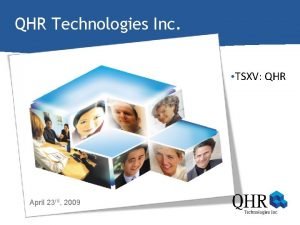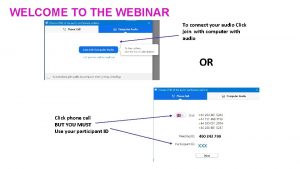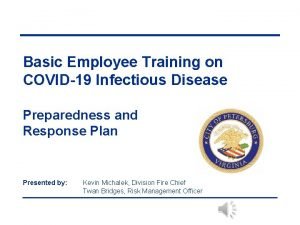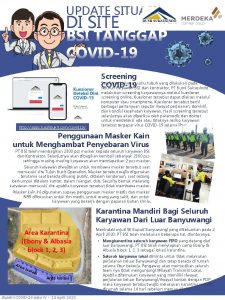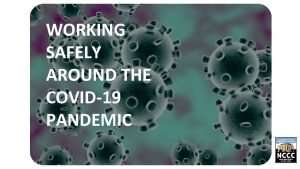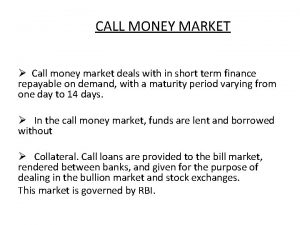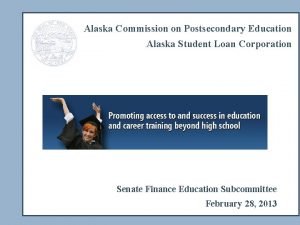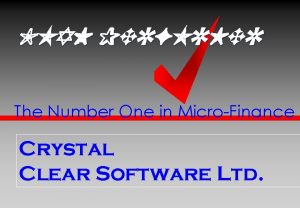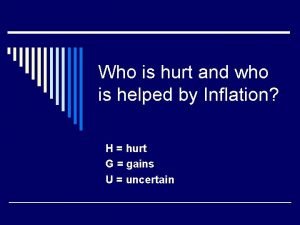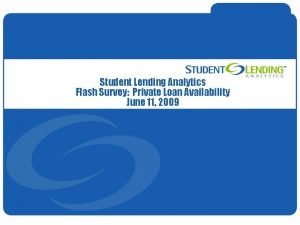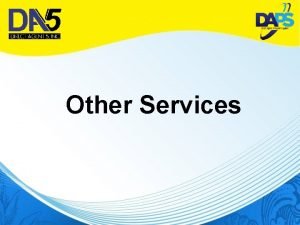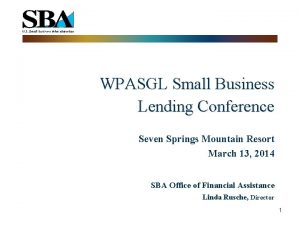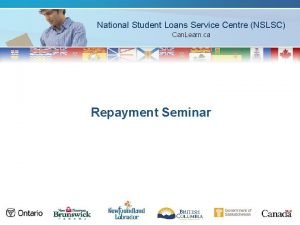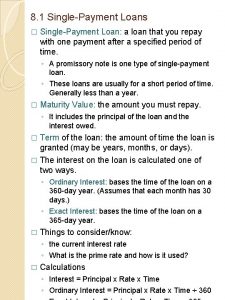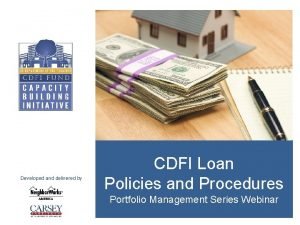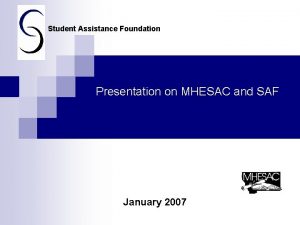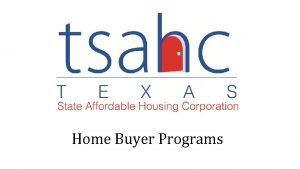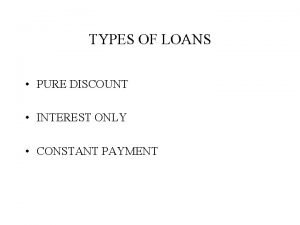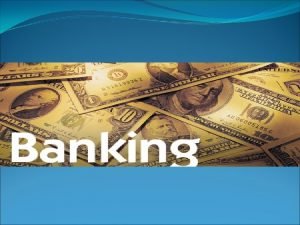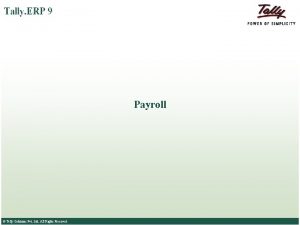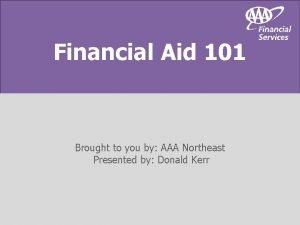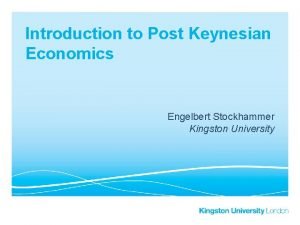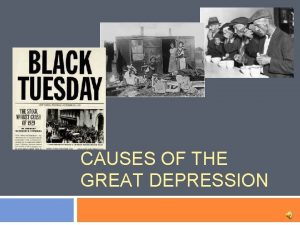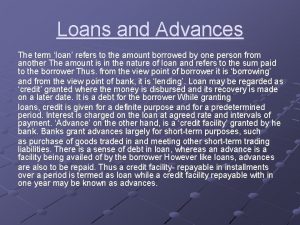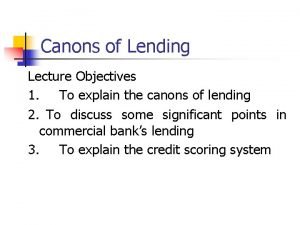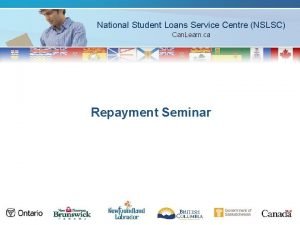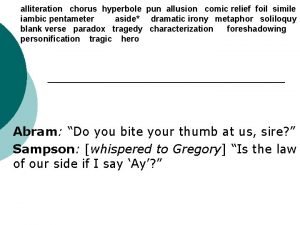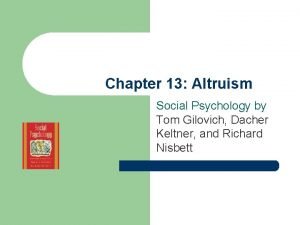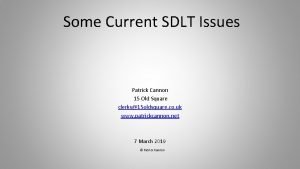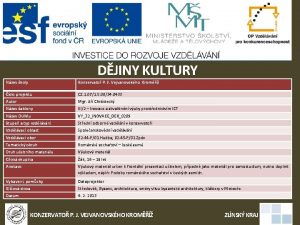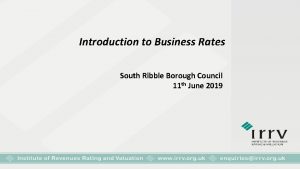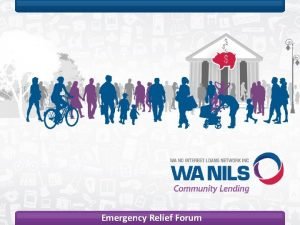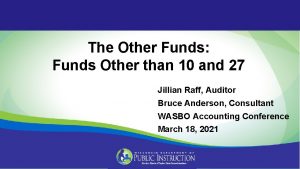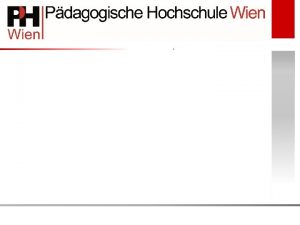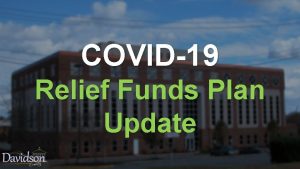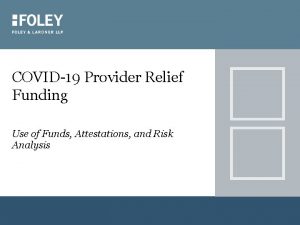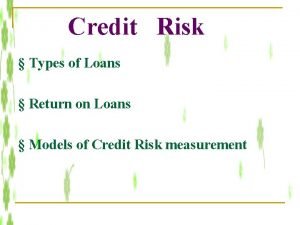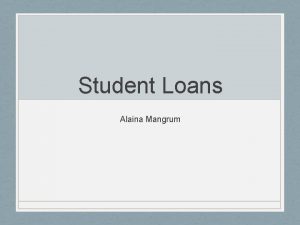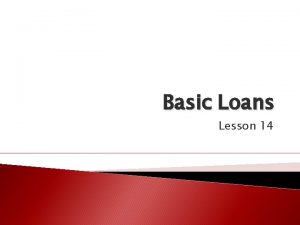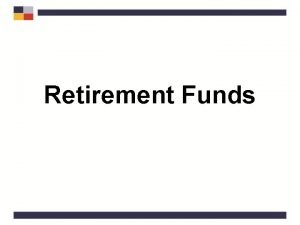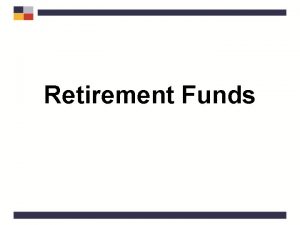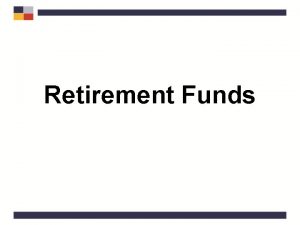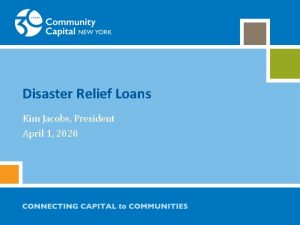COVID19 Emergency Relief Funds Loans Other Funds QHR





























































- Slides: 61

COVID-19: Emergency Relief Funds, Loans & Other Funds QHR Health Finance and HFR June 8, 2020 Proprietary & Confidential 1

Funding Available during COVID-19 Pandemic • Funds originating with acts of Congress – – Short term loans Direct payments Federal and state grants Various “waivers” • Payment regulations not applicable during COVID-19 • Hospital conditions of participation regulations waivers – Disaster assistance • Administered by FEMA • Funds already set aside by Congress plus CARES Act – IRS Tax Deferrals and Unemployment Taxes • Others? ? – Charitable trusts – Community support/volunteers Proprietary & Confidential 2

Overview of Funding Available Acts of Congress due to COVID-19 3/6/20 3/18/20 3/27/20 4/24/20 Passed House and Senate on 6/4/20 Signed by President on 6/5/20 Coronavirus Preparation Act Family First Act Coronavirus Aid, Relief & Economic Security Act (CARES) Paycheck Protection Program & Health Care Enhancement Act Paycheck Protection and Program Flexibility Act of 2020 Proprietary & Confidential 3

Rulemaking in Light of COVID-19 Pandemic • Declaration of national health emergency on March 13, 2020: – FEMA assistance triggered – Federal agencies authorized to “waive” current regulations – CMS waivers alone are a 40+ page document • Waivers are too many to list – Provider-based regulations and telehealth expansions – CAH bed size and SNF 3 acute care stay – Hospital and RHC expansions – Go to this link for some midnight reading!! – https: //www. cms. gov/about-cms/emergency-preparedness-responseoperations/current-emergencies/coronavirus-waivers Proprietary & Confidential 4

CMS Annual Rulemaking Cycle • Federal agencies implement legislation, acts of Congress, signed into law by the President of the United States – Required to follow the Administrative Procedures Act • Publish regulations in “proposed” status in Federal Register • Accept comments from US citizens during 90 -day comment period • Publish regulations in “final” format in Federal Register – Must respond to ALL comments received from US citizens – HHS/CMS major annual rules published 30 days after the end of comment period – During pandemic, federal agencies have not been going through this process • Issuing “interim final rules” versus proposed and then final regulations in FR • FAQs have taken place of “comment period” Proprietary & Confidential 5

CARES Act: Section 5001 Emergency Relief Funds Dates Amount Distributed 4/10/20 $30 All FFS providers Funds received based on provider Medicare Reimbursement relative to total Medicare Reimbursements for FY 2018 4/24/20 $20 All FFS providers 4/26/20 $10 Hospitals in “hot spots” Funds received based provider total “net revenues” relative to total providers net revenues. Focus on providers in areas particularly impacted by the COVID-19 outbreak. Payment based on ICU Beds and number of COVID-19 inpatient admissions 4/26/20 $10 Rural Hospitals and RHCs Designated for Rural Hospitals and Medicare Certified Rural Health Clinics May $10 Providers treating uninsured Hospitals will submit “bills” to MAC in and receive reimbursement under Medicare payment rates Late May $20 SNFs, nursing homes and other high Medicaid used provider types: Total $100 Total emergency relief funds in CARES Act for “lost revenue” & COVID-19 costs: deemed grants in CARES Act Section 5001 Available Note Section 5001 of the CARES Act appropriated $129 billion in emergency relief funds to all providers: $100 billion for lost revenues and additional $29 billion for direct costs related to COVID-19 emergency preparation costs. Funds distributed by HHS/CMS and do not require repayment, except for first 2 payments received in April: these payments must be less then “lost revenues” for March and April and less then 2% of hospitals net revenues in 2018. Providers must document use of funds and whether funds used for "costs of COVID-19" or “lost revenues” Proprietary & Confidential 6

Paycheck Protection Program and Health Care Enhancement Act Dates Amount Distributed TBD $75. 0 All provider types HHS has promised prompt distribution of funds TBD $11. 0 All provider types For states, localities, territories, and tribes to develop, purchase, administer, process, and analyze COVID-19 tests, scale-up laboratory capacity, trace contacts, and support employer testing. Funds are also made available to employers for testing. TBD $1. 0 All provider types Payments to providers for COVID-19 diagnostic tests when patient does not have health insurance May $. 83 RHCs and FQHCs RHCs started receiving funds the last week of May Available Note Legislation also includes $350 billion funding for PPP administered by the SBA. Proprietary & Confidential 7

CARES Act: Financial Assistance Agency Description Treasury/ Provider Emergency states Relief: for governmental entities ONLY Available Loan/Grant Note Pending Grant Provide emergency relief, $150 billion to states and large counties. Funding flows from US Treasury to applying states or counties. States then distribute other "government entities". Covers costs incurred due to COVID-19 emergency. FCC Telecommunication equipment grants FCC website Grants available for "telecommunication" equipment to allow for hospitals and other providers to effectuate telehealth services FEMA Disaster assistance FEMA website Grant 75% of costs incurred preparing for COVID-19. Must document costs incurred and file application to receive funds. Proprietary & Confidential 8

CARES Act: Loans CARES Section Agency CMS/MAC 110 X SBA 110 X 4001 SBA Description Available Loan/Grant Accelerated payments MAC website Loan Paycheck Protection Program Go to SBA website, apply with your SBA lender, governmental hospitals are eligible now. Loan Economic Injury Disaster Loan (EIDL) Go to SBA website, governmental hospitals not eligible Loan https: //www. sba. gov/fundingprograms/disaster-assistance Federal Main Street New Loan Reserve/Bank Facility Contact state, State Hospital Financing Authority or State Hospital Association Loan Terms Note Withholds begin day 1. Loan based on hospital reimbursements 121, paid in full at from prior periods. Amounts vary by 365 days provider type. 2. CMS has placed on hold till further notice Forgiveness of loan if 1. <500 employees, mo. avg payroll 1 x 2. 5, certain SBA thresholds Max = $10 M. are satisfied 2. Must spend 60% on employee compensation and 40% on other defined costs Max = $2 M. Sick pay, payroll, rent/mortgage/increased supply costs, Amount can be rolled other obligations unable to meet due to into PPP loan and revenue loss. then Forgiven 2. 75%, up to 30 years repayment No forgiveness Eligible borrowers are businesses with up to 10, 000 employees or up to $2. 5 billion in 2019 annual revenues. Also allows large municipalities, large cities and states to effectuate loans and then loan proceeds to qualifying governmental hospitals Proprietary & Confidential 9

CARES Act: Payroll Tax and IRS Credits Act Agency CARES HHS 50% unemployment funding Family First Act IRS Paid sick leave requirement: employers required to provide 80 hours paid time off to COVID-19 inflicted employees or caregivers to https: //www. irs. g ov/newsroom/co COVID-19 inflicted or Children vid-19 -related. Paid family time: caregivers taking tax-credits-forfamily leave under FMLA to care for required-paidchildren, up to 10 weeks time off leave-providedrequired by-small-and. Employee retention credit midsizebusinesses-faqs CARES IRS Description Payroll tax deferral Available Loan/Grant Terms Note Contact state unemployment/ legal counsel No repayment Hospital pays 50%, state pays 50%. State reimbursed from feds. IRS website Tax credit equal to "paid wages", health benefits and employer SSI Tax Credit Deferral IRS taxes due forgiven: obtain during quarterly tax filing Repayment in 2021 and 2022 Tax credit equal to 50% of paid wages, up to $10, 000 per employee "not paid" due to COVID -19 suspension of business or 50% decrease in receipts from 2019 Delay of 2 quarters Cannot do if obtain SBA 7 b, PPP Loan Proprietary & Confidential 10

Accelerated Payments: Loan Amounts Hospitals 6 months of Medicare reimbursements Critical Access Hospitals 6 months of Medicare reimbursements at 125% All other providers/suppliers 3 months of Medicare reimbursements Repayments start 120 days after via claims withholding at 121 days Paid in full at 365 days CMS/MAC would likely accept repayment plans: see PRM Part I, Chapter 26 Single page application by NPI Number Most are summarizing Medicare reimbursements for last 12 months and arriving at average per month Proprietary & Confidential 11

Emergency Relief Funds • Section 5001 of CARES appropriates – $129 billion to all hospitals, CAHs and other providers • $29 billion to compensate for “costs” related to COVID-19 disaster • $100 billion for lost revenues and expenses – Language of CARES: “Lost Revenues” » Congressional intent: reimburse hospitals for ceasing elective services • $30 billion distributed as of 4/16/20 • $20 billion distributions started on 4/26/20 – Reporting of lost revenues: March April 2020 to 2019 or to 2020 budgets – Submit tax returns or financials for government entities • Must certify receipt of funds: funds used for hospital services, is needed, etc. • HHS and CMS have set up “certification” portals Proprietary & Confidential 12

ERFs: Section 5001 CARES for Govt. Entities • Section 5001 of CARES appropriates also provides reimbursement to governmental entities – $150 billion for states and large municipalities • Funds will flow to states from the federal government • States will distribute to qualifying municipalities and other local governments – Funds available with following conditions: • Necessary expenditures incurred due to the public health emergency concerning the Coronavirus disease 2019 (COVID-19) • Not in the budget most recently approved as of March 27, 2020 (the date of enactment of the CARES Act) for the state or government • Costs incurred during the period that begins on March 1, 2020, and ends on December 30, 2020 Proprietary & Confidential 13

ERFs: Section 5001 CARES for Govt. Entities • Contact state HHS and or State Hospital Authority • Go to the following link for: – Funding by state and large municipality • WY gets $0. 6 billion • NY gets $19. 5 billion – Fact sheets and FAQ document – https: //home. treasury. gov/policy-issues/cares/state-and-local-governments • This is a broad range of funding for addressing the health emergency with multiple recipients Proprietary & Confidential 14

ERFs: Section 5001 CARES for Govt. Entities • Covered, reimbursable expenses include medical expenses: – COVID-19 -related expenses of public hospitals, clinics, and similar facilities – Establishing temporary public medical facilities and other measures to increase COVID-19 treatment capacity, including related construction costs – Costs of providing COVID-19 testing, including serological testing – Emergency medical response expenses, including emergency medical transportation, related to COVID-19 – Expenses for establishing and operating public telemedicine capabilities for COVID-19 related treatment Proprietary & Confidential 15

ERFs: Section 5001 CARES for Govt. Entities • Covered, reimbursable expenses include public health – Communication and enforcement by state, territorial, local, and tribal governments of public health orders related to COVID-19 – Acquisition and distribution of medical and protective supplies, including sanitizing products and personal protective equipment for medical personnel, police officers, social workers, child protection services, and child welfare officers, direct service providers for older adults and individuals with disabilities in community settings, and other public health or safety workers in connection with the COVID-19 public health emergency – Disinfection of public areas and other facilities, e. g. , nursing homes, in response to the COVID-19 public health emergency – Technical assistance to local authorities or other entities on mitigation of COVID-19 -related threats to public health and safety – Public safety measures are undertaken in response to COVID-19 – Expenses for quarantining individuals Proprietary & Confidential 16

ERFs: Section 5001 CARES for Govt. Entities • Covered reimbursable expenses include: – Payroll expenses for public safety, public health, health care, human services, and similar employees whose services are substantially dedicated to mitigating or responding to the COVID-19 public health emergency – Expenses of actions to facilitate compliance with COVID-19 -related public health measures, such as: • Food delivery to residents, including senior citizens and other vulnerable populations, to enable compliance with COVID-19 public health precautions • Facilitate distance learning, including technological improvements, in connection with school closings, to enable compliance with COVID-19 precautions • Improve telework capabilities for public employees to enable compliance with COVID-19 public health precautions • Providing paid sick, family, and medical leave to public employees to enable compliance with COVID-19 public health precautions • Maintaining state prisons and county jails, including as relates to sanitation and improvement of social distancing measures, to enable compliance with COVID-19 public health precautions • Care for homeless populations provided to mitigate COVID-19 effects and enable compliance with COVID-19 public health precautions Proprietary & Confidential 17

ERFs: Section 5001 CARES for Govt. Entities • Covered reimbursable expenses include: – Economic support: • Provision of grants to small businesses to reimburse the costs of business interruption caused by required closures • State, territorial, local, or tribal government payroll support program • Unemployment insurance costs related to the COVID-19 public health emergency – Assuming cost not reimbursed by the federal government under the CARES Act or otherwise – Any other COVID-19 related expenses reasonably necessary to the function of government • Must meet general criteria: related to COVID-19 Proprietary & Confidential 18

FCC Telecommunication Grants Available to Hospitals and Physicians $200 Million in Grant Funds for: - Telecommunications services - Information service’s devices necessary to provide critical connected care services Separate and Distinct Application Process - As a grant must go through the registration process - Account for funds received and how spent Applications are Now Available on FCC Website - Standard form of a grant application - Names, dates, what the funds are for, etc. - https: //www. fcc. gov/covid-19 -telehealth-program Proprietary & Confidential 19

FCC Telecommunication Grants: First 3 Steps STEP 1 Obtain an eligibility determination from the Universal Service Administrative Company (USAC) STEP 2 Obtain an FCC Registration Number (FRN) in the FCC Registration System (CORES) • File FCC Form 460 • • https: //www. usac. org/rural-health -care/resources/forms/ https: //apps. fcc. gov/cores/user. Log in. do • Typical web-based system: user name, TIN, etc. STEP 3 Register with the system for award management • • https: //www. sam. gov/SAM/ • DUN number (allows the government to track funds) Will need TIN or EIN, bank routing number along with bank information to allow for ETF – If your organization does not yet have a DUNS number, or no one knows it, visit the Dun & Bradstreet (D&B) website: https: //fedgov. dnb. com/webform/display. Ho me. Page. do or call 1 -866 -705 -5711 Proprietary & Confidential 20

FCC Telehealth Grants - Funds For: • Telecommunications services and broadband connectivity services: – Voice services, and internet connectivity services for health care providers or their patients • Information services: – Remote patient monitoring platforms and services; patient-reported outcome platforms; store and forward services, such as asynchronous transfer of patient images and data for interpretation by a physician; platforms and services to provide synchronous video consultation • Internet connected devices/equipment: – tablets, smartphones, or connected devices to receive connected care services at home (e. g. , broadbandenabled blood pressure) • General website to HRSA Grant Programs – https: //bhw. hrsa. gov/grants Proprietary & Confidential 21

SBA: Paycheck Protection Program • One-page application plus attestation page to start the process – CARES mandates SBA streamline the process and removed lending barriers to 6/30/2020 – The lender will “reserve” loan amount for 10 days • Regulations: – https: //www. ecfr. gov/cgi-bin/text-idx? rgn=div 5; node=13%3 A 1. 0. 1. 1. 17#se 13. 1. 121_1106 • For small businesses including 501 c nonprofits – Governmental hospitals can now qualify due to PPP and Health Care Enhancement Act • The math: – Monthly average payroll times 2. 5 equals the loan amount • Max loan is $10 million • Loan is for 2/15/2020 to 6/30/2020 expenditures – Revised to 12/31/2020 Proprietary & Confidential 22

SBA: Paycheck Protection Program • Qualifying business: three mutually exclusive qualifying criteria – 500 or fewer employees based on average over the last 12 months OR – SBA secondary standards • Revenue or employee size – SBA has distinct revenue and employee size standard for each industry in the USA – For hospital standards, it is $41. 5 million in revenues, $30 million for nursing homes, $12 million for physician practices, etc. – There is not a separate employee threshold – Go to the SBA published document titled: » • Table of Small Business Size Standards Matched to North American Industry Classification System Codes Equity and income standard – Hospital has net equity less than $15 million – Net income less than $5 million over the last 2 years Proprietary & Confidential 23

SBA: Paycheck Protection Program • Loan amount used for payroll costs and other eligible costs – Payroll costs: • Employee salaries, commissions, wages and other cash compensation • Employer contributions to defined-benefit or defined-contribution retirement plans • Payment for the provision of employee benefits consisting of group health care coverage, including insurance premiums • Payment of state and local taxes assessed on the compensation of employees • Costs related to the continuation of group health care benefits during periods of paid sick, medical, or family leave, and insurance premiums Proprietary & Confidential 24

SBA: Paycheck Protection Program • Payroll costs defined: from interim final rule published on May 23 rd, 2020 – Payroll costs consist of compensation to employees (whose principal place of residence is in the United States) in the form of salary, wages, commissions, or similar compensation; cash tips or the equivalent (based on employer records of past tips or, in the absence of such records, a reasonable, good-faith employer estimate of such tips); payment for vacation, parental, family, medical, or sick leave; an allowance for separation or dismissal; payment for the provision of employee benefits consisting of group health care coverage, including insurance premiums, and retirement; payment of state and local taxes assessed on the compensation of employees; and for an independent contractor or sole proprietor, wages, commissions, income, or net earnings from self-employment, or similar compensation. See 15 U. S. C. 636(a)(36)(A)(viii); 85 FR 20811, 20813. Proprietary & Confidential 25

SBA: Paycheck Protection Program • Loan amount used for payroll costs and other eligible expenses – Other eligible costs • Rent (including rent under a lease agreement); • Utilities • Interest on any mortgage obligation on real or personal property : – Debt incurred before 2/15/2020 – Interest ONLY, and not the principle – Not including prepayments Proprietary & Confidential 26

SBA: Paycheck Protection Program • Loan FORGIVENESS!! – Amounts spent from receipt of funds date up to 8 weeks 12/31/2020 – Forgiveness covers eligible payroll and other defined costs: • Payroll, interest payments on mortgage obligation, rents or lease and utilities • Contracts entered before 2/15/2020 • Eligible payroll costs do not include compensation above $100, 000 in wages – If 75% of loan utilized for payroll and payroll-related costs, the loan is forgiven in whole – Revision by Paycheck Protection and Program Flexibility Act of 2020!! • 60/40 Spend Requirement – 60% to Payroll Costs – 40 % to other Eligible Costs Proprietary & Confidential 27

SBA: Paycheck Protection Program • Loan FORGIVENESS process – Loan forgiveness application completed by borrower • SBA form 3508 or lender equivalent – The lender has 60 days to issue decision to SBA and borrower – SBA issues payment to lender within 90 days of lender decision to forgive loan • SBA will review lender decisions within this 90 -day period • Separate review and audit guidelines will be published by SBA in separate interim final rule • SBA MAY NOT approve at this step Proprietary & Confidential 28

SBA: Paycheck Protection Program • Payroll costs eligible forgiveness – Payroll costs PAID or INCURRED during the covered period • Covered period equals eight consecutive weeks from: – Date lender disbursed the PPP loan funds OR – First day of first payroll cycle in the covered period • IF using incurred, payroll costs must be paid in the next payroll cycle after the COVERED PERIOD ends • Employees on payroll but not actually working any hours – Base on typical employee schedule Proprietary & Confidential 29

SBA: Paycheck Protection Program • Example: A borrower has a bi-weekly payroll schedule (every other week). The borrower’s eightweek covered period begins on June 1 and ends on July 26. The first day of the borrower’s first payroll cycle that starts in the covered period is June 7. The borrower may elect an alternative payroll covered period for payroll cost purposes that starts on June 7 and ends 55 days later (for a total of 56 days) on August 1. Payroll costs paid during this alternative payroll covered period are eligible forgiveness. In addition, payroll costs incurred during this alternative payroll covered period are eligible forgiveness as long as they are paid on or before the first regular payroll date occurring after August 1. Payroll costs that were both paid and incurred during the covered period (or alternative payroll covered period) may only be counted once. • THIS EXAMPLE WILL BE REVISED TO REFLECT DECEMBER 31, 2020 DEADLINE UPON PUBLICATION OF INTERIM FINAL RULE INCORPORATING CHANGES BY PAYCHECK PROTECTION AND PROGRAM FLEXIBILITY ACT OF 2020 Proprietary & Confidential 30

SBA: Paycheck Protection Program • Payroll costs eligible forgiveness – Payroll costs include furloughed employees, hazard pay and bonuses – Eligible amount excludes compensation and pay greater than $100 k per year • Prorate compensation over the covered period – Annual compensation divided by 52 weeks times 8 weeks – Bonus payments or hazard pay > $100 k ARE forgiven • CAPS apply for owner/employees • Other eligible costs – Paid during covered period OR – Incurred during the covered period Proprietary & Confidential 31

SBA: Paycheck Protection Program • Loan amount forgiven reduced IF: – The hospital does not spend 75% 60% of loan on payroll costs • Regulation states “up to 40% of non-payroll costs” will be forgiven • Keep as close to 60% as possible to avoid accusations of fraud and abuse and maximize forgiven amount – Actual math • Eligible payroll costs for eight-week covered period divided by 75% 60% equals forgiveness amount • This assumes zero reductions due to FTE or pay rate reductions • Will discuss in following slides Proprietary & Confidential 32

SBA: Paycheck Protection Program Loan Amount Requested and Forgiven Example Loan Received Average monthly payroll $1, 000 Maximum loan amount factor Forgiven Amount 2. 5 Total loan received by hospital $2, 500, 000 Payroll costs incurred or paid during covered period $1, 500, 000 Divide by repayment threshold Loan amount forgiven . 60 $2, 500, 000 Target payroll costs to equal 75% of loan amount to avoid repayments Proprietary & Confidential 33

SBA: Paycheck Protection Program Loan Amount Requested and Forgiven Example Loan Received Average monthly payroll Maximum loan amount factor Total loan received by hospital Forgiven Amount $1, 000 Payroll costs incurred or paid during eight-week covered period 2. 5 $2, 500, 000 $500, 000 Threshold Loan amount forgiven . 60 $833, 333 Hospital could be accused of false loan certification if actual payroll expenditures are significantly less then 60% of Loan Amount. Question is how much less than 60% ? Proprietary & Confidential 34

SBA: Paycheck Protection Program • Loan amount forgiven also reduced IF: – Reduce FTE count of employees – Reduces pay rates by 25% or more for any employee excluding those with salary > 100 k • You have until June 30, 2020, December 31, 2020 to restore your full-time employment and salary levels for any changes made between February 15, 2020, and April 26, 2020. – Determination is made on an employee by employee basis • Interim final rule, published May 22, 2020, confirms • Paycheck Protection and Program Flexibility Act of 2020 – Additional Waivers to FTE and Compensation Reductions • Business cannot hire like qualified employees • Business cannot yet ramp up due to Government Restrictions Proprietary & Confidential 35

SBA: Paycheck Protection Program • Loan forgiveness reductions: FTE reduction occurs – FTEs decrease from “covered or alternative period” to reference period, amount forgiven will be reduced – Reference period is one of the following: • 2/15/2019 to 6/30/2019 OR • 1/1/2020 to 2/29/2020 • Seasonal employers: – As above or 12 consecutive weeks between 5/1/2019 to 9/15/2019 – Example • 100 FTEs in reference period • 80 FTEs in covered period • 80% of eligible expenses forgiven • These sections may be revised when regulations implementing the Paycheck Protection and Program Flexibility Act of 2020 are issued Proprietary & Confidential 36

SBA: Paycheck Protection Program • Loan forgiveness: FTE reduction occurs (cont. ) – Counting FTEs • Count FTEs on an employee by employee basis – Use averages during the covered period and reference period – Remember: SBA is loaning to many types of business entities, not just hospitals! • Average number of hours paid per week divided by 40 equals FTE – IF FTE is greater than 1. 0, count only 1 FTE – IF FTE is less than 1. 0 either: • » Use actual computation: 30 avg hours divided by 40 equals 0. 75 FTE or » Use 0. 5 FTE for each employee less than 40 hours » Whichever you choose, you must follow for ALL employees Include employees dismissed for cause, voluntary resignations and employee requested scheduled hour reductions in FTE Counts Proprietary & Confidential 37

SBA: Paycheck Protection Program • Loan forgiveness: compensation reduction – Direct compensation decrease > 25%, triggers a decrease in loan forgiveness amount – Determine on an employee by employee basis – Example on the following slide – As with FTE counts, correcting by June 30, 2020 will void this penalty Proprietary & Confidential 38

SBA: Paycheck Protection Program Example: Payrate or Salary Reduction Greater than 25% Annual Weekly Salary $1, 000 Weekly Compensation During Covered Period $700 Reduction Amount $300 Reduction as a Percent 30% 25% Exemption by Statute 25% Excess Reduction 5% Weekly Excess Pay Reduction (1, 000 x 5%) $50 Covered Period Loan Amount Forgiven Reduced for this Employee 8 weeks $400 See CARES Act, Section 1106(d)(5) for language Proprietary & Confidential 39

SBA: Paycheck Protection Program • Documentation requirements: – As stated in the original loan forgiveness application • Must PROVIDE via application • Must MAINTAIN and make available upon request • MAY provide to lender with application – See page 10 of application form and Instructions for a complete listing • Payroll reports, bank statements, receipts, etc. • For hospitals, the data will be extensive!! • Remember, SBA is intended for small businesses, with few employees in normal times Proprietary & Confidential 40

SBA: Paycheck Protection Program • Repayment terms – Repayments deferred for at least 6 months but NOT more than 12 – 2 -year term: Revised to 5 -year term – Interest rate 1% – Costs reimbursable on cost report • Audits and reviews: – Any loan > $ 2. 0 million subject to audit – Smaller loans on a sample basis – Hospitals must do three things to pass audit: • Documentation – Go to SBA Loan Forgiveness Applications and Instructions for Documentation Guidelines Proprietary & Confidential 41

SBA: Paycheck Protection Program, Employee Counts, Section 121. 106 • (a) In determining a concern's number of employees, SBA counts all individuals employed on a fulltime, part-time, or other basis. This includes employees obtained from a temporary employee agency, professional employee organization or leasing concern. SBA will consider the totality of the circumstances, including criteria used by the IRS for federal income tax purposes, in determining whether individuals are employees of a concern. Volunteers (i. e. , individuals who receive no compensation, including no in-kind compensation, for work performed) are not considered employees. • (b) Where the size standard is the number of employees, the method for determining a concern's size includes the following principles: – The average number of employees of the concern is used (including the employees of its domestic and foreign affiliates) based upon numbers of employees for each of the pay periods for the preceding completed 12 calendar months – Part-time and temporary employees are counted the same as full-time employees – If a concern has not been in business for 12 months, the average number of employees is used for each of the pay periods during which it has been in business Proprietary & Confidential 42

Small Business Administration Loans • Emergency Economic Injury Disaster (EIDL) grants – CARES expanded eligibility to various entities including 501 c • Agricultural cooperatives, tribal entities, ESOP • Waives personal guarantee, one year in business requirement and “last resort lender” requirement – Current regulations state business cannot get credit elsewhere • Advance of $10 k made within three business days • Maximum loan up to $2 million – Section 7(b)(2) of the Small Business Act (15 U. S. C. 636(b)(2)). – Funds used for: • Sick pay due to COVID-19 ailments • Payroll maintenance • Rent and mortgage • Increased costs of supplies due to supply chain interruptions • Payment of other “obligations” that cannot be met due to revenue loss – Repay grant for unemployment proceeds – Grants available till 12/31/2020 with a repayment of 30 Years Proprietary & Confidential 43

Small Business Administration Loans • Emergency Economic Injury Disaster (EIDL) Grants vs Paycheck Protection? – Paycheck has generous “forgiveness” provisions – Depending on hospital size, more funds available under Paycheck • Annual Payroll; $9, 600, 000 • Months 12 • Multiplier 2. 5 • Maximum EIDL Loan $2, 000 • Maximum Paycheck Loan $10, 000 – EIDL can be converted into Paycheck Protection loan – Obtain EIDL and then convert to Paycheck? Proprietary & Confidential 44

Section 4001 Loans: Main Street Loans • For business entities, states and municipalities – Government hospitals should access – Work with state hospital finance authority – State issues debt – Funds with repayment terms to hospital district or county/city • Banks lends while Federal Reserve providing funds and guarantees • Federal Reserve has issued FACT sheets Proprietary & Confidential 45

Section 4001 Loans: Main Street Loans • Restrictions – Credit is not reasonably available – Obligation is prudently incurred – Loan is reasonably secured – Term is no longer than five years – Stock buybacks are barred for the life of the loan, plus one year – excepting current contractual obligations – Dividends and other capital distributions are barred for the life of the loan, plus one year – Maintain employment at 90% March 24, 2020 – Certify business “created or organized in the U. S. or under U. S. law and have significant operations and employees based in the U. S. ” – Must have losses that jeopardize continued business operations • Secretary shall determine Proprietary & Confidential 46

FEMA Grants: Reimbursements • For business entities, states and municipalities • Costs related to COVID-19 emergency preparedness: 75% reimbursed • Initial application due 60 days from March 13, 2020 – Date national emergency declared • What type of costs to claim? ? ? – See following slides for AHA wish list – FEMA guidelines available but…. limited since pandemic has never occurred before!! – Direct and indirect costs: compensation costs as well • Accounting for costs related to COVID-19 – Separate departments and GL accounts – Consider using clearing accounts to track expenses and FEMA claim Proprietary & Confidential 47

Food for Thought: Types of Costs FEMA will Reimburse • Expenses related to surge capacity for Coronavirus, including: – Construction or retrofitting of infrastructure to create capacities, such as additional triage and treatment areas and command centers – Acquisition of equipment and supplies such as beds, ventilators, diagnostic testing supplies, personal protective equipment, pharmaceuticals and safety equipment, even if the acquired equipment and supplies are not deployed – Costs for setting up drive-through testing and additional screening for every patient at the entrances to hospitals and outpatient facilities – Acquisition of additional technology such as telehealth equipment, command center technology and software – Relocation of existing equipment/supplies/infrastructure to other parts of a system or the country, and the cost of leasing distribution and storage space – Additional security for hospitals and for temporary medical facilities – Triage activities to manage the surge Proprietary & Confidential 48

Food for Thought: Types of Costs FEMA will Reimburse • Expenses related to ensuring an adequate workforce for Coronavirus, including: – Overtime and emergency pay for existing employees, including to create additional standby capacity – Salaries, benefits, overtime, emergency pay and other expenses for new/re-hired/temporary/contract employees, including those hired to create additional standby capacity – Paid leave for quarantined or furloughed staff – Housing costs for quarantined staff needing to self-isolate – Hotel/housing costs for staff to enable longer work hours (e. g. through shorter commutes) – Additional administrative expenses associated with planning, coordinating and staffing the pandemic response Proprietary & Confidential 49

Food for Thought: Types of Costs FEMA will Reimburse • Other health care expenses related to Coronavirus, including: – Managing and treating persons under investigation (PUIs) who may or may not turn out to be COVID-19 positive – Where needed, distributing one-time 30 -day supplies of prescriptions for acute conditions or to replace maintenance prescriptions – If necessary, mortuary services – Purchase or lease of temporary generators for facilities that provide essential community services – Hotel/housing costs for discharged patients who require isolation, but cannot do so at home – Hotel/housing/boarding costs for discharged patients for whom placement is not (yet) possible (e. g. , nursing homes refuse placement) – Interest charged on Medicare “accelerated” or other payments – Interest charged on any loans taken out due to the emergency – Costs associated with monitoring non-hospitalized patients Proprietary & Confidential 50

Section 2103 Unemployment Funding • Applicable to nonprofits and governmental hospitals – Employee is furloughed and receives unemployment from the state – Hospitals only pay 50% of unemployment payments made to employee to state – State gets reimbursed from the federal government for other 50% – US Federal Labor Department managing in conjunction with state – Contract your state unemployment/legal counsel – Remember: claim out-of-pocket costs on FEMA refund! Proprietary & Confidential 51

IRS Payroll Deferral Program • Applicable to all business entities: hospital types: for-profit, governmental, 501 c • Delay of payroll taxes of two quarters • Cannot take this if hospital obtains SBA 7 b loan, Paycheck Protection Program • Paycheck Protection and Program Flexibility Act of 2020 – Removed prohibition applicable to PPP lenders!! • Repay at end of 2021 and 2022 in two payments Proprietary & Confidential 52

IRS Tax Credits • Three types of IRS tax credits – Employee Retention Credit – Paid Sick Leave Credit – Paid Family Leave Credit • Credit claimed by NOT paying employment taxes due • Provides some latitude to offer time off to staff and reduce costs of unemployment • Paycheck Protection and Program Flexibility Act of 2020 – Revised CARES Act sections preempting PPP lenders from qualifying! Proprietary & Confidential 53

CARES Act Section 2301: Employee Retention Credit • 50% tax credit on qualified wages – – Available for last three calendar quarters of 2020 to employers who pay employment taxes No repayment required • Qualifying employers: – – – Have a 50% decrease in gross receipts in a quarter as compared to the same quarter in 2019 OR Had to fully or partially suspend operations under government order • Hospital can claim CDC ordered elective services be stopped? ? • Awaiting further IRS Clarification Cannot qualify if SBA Paycheck Protection Program loan obtained • Credit based on average number of full-time employees in 2019 – – Less than 100: qualified wages paid in 2019 More than 100: qualified wages paid during the business suspension period • Qualified wages equals compensation plus employee health benefit plan – – Qualified wages excludes sick pay or family leave pay due to Family First Act requirements Separate credits available for these types of wages Proprietary & Confidential 54

Employee Retention IRS Tax Credit: • How much is the credit? – Credit is equal to 50% of qualified wages paid (either in 2019 or during business suspension) • Qualified wages capped at $10, 000 per employee • Maximum credit is $5, 000 per employee – Credit can cross quarters • Pay is $8, 000 in 2 nd quarter: credit equals $4, 000 • Pay is $4, 000 in 3 rd quarter: credit equals $1, 000 – A $5, 000 reduction in taxes due per employee retained during COVID-19 • Are you better off with the SBA paycheck loan or the tax credit? ? • IF you do not qualify for PPP, reduces the impact of staff layoffs or costs of retaining core staffing at the facility Proprietary & Confidential 55

Family First Act: Paid Sick Leave Tax Credit • Applicable to employers with 500 or fewer employees & not a government entity • Hospitals required to provide 80 hours paid sick leave if employee is ill with COVID-19 • Hospital required to provide 10 Weeks in defined “family member” care situations • IRS tax credit equals: – Paid wages plus – Medicare tax on paid sick leave wages plus – Allocable cost of maintaining health insurance coverage during the sick leave period – Employer is NOT subject to employer portion of social security tax on sick leave wages. • https: //www. irs. gov/newsroom/covid-19 -related-tax-credits-for-required-paid-leave-provided-bysmall-and-midsize-businesses-faqs Proprietary & Confidential 56

Family First Act: Paid Sick Leave Tax Credit 80 Hours Paid Sick Leave EMPLOYEE, Due to COVID-19 Pay rates Under a federal, state, or local quarantine or isolation order • • Been advised by a health care provider to self-quarantine Experiencing symptoms of COVID-19 and seeking a medical diagnosis Caring for an individual who is subject to a federal, state, or local quarantine, isolation order advised by a health care provider to self-quarantine Caring for the child due to school or childcare provider is unavailable • • Regular rate of pay: IF pay rate is higher than federal, state or local minimum wage Up to $511 per day and $5, 110 in the aggregate 2/3 the employee’s regular rate of pay: IF higher than federal, state or local minimum wage Up to $200 per day and $2, 000 in the aggregate Experiencing any other substantially similar condition specified by the U. S. Department of Health and Human Service Proprietary & Confidential 57

Family First Act: Paid Family Leave Credit • Applicable to hospitals with less than 500 employees and not a government entity • IF employee takes leave to take care of a child: – School closed or childcare center closed due to COVID-19 • Required 10 weeks of paid time off – Employee regular up to $200 per day and $10, 000 in the aggregate. – Up to ten weeks of qualifying leave can be counted towards the family leave credit – IRS tax credit equals • Required paid sick leave plus • Medicare tax on paid sick leave wages • Allocable cost of maintaining health insurance coverage during the sick leave period • Employer NOT subject to employer portion of social security tax ion sick leave wages • https: //www. irs. gov/newsroom/covid-19 -related-tax-credits-for-required-paid-leave-provided-bysmall-and-midsize-businesses-faqs Proprietary & Confidential 58

Claiming the Tax Credits with the IRS • Tax credit received by NOT paying employment taxes when due – IRS taxes that will not be remitted to the IRS: • Federal income tax • Employee share of social security and Medicare taxes • Employer share of social security and Medicare taxes – IF credits exceed IRS Taxes above due? ? • File IRS form 7200 to receive a cash payment!! Proprietary & Confidential 59

For More Information Contact: (615) 371 -4678 jwaltko@qhr. com Proprietary & Confidential 60

Thank You Proprietary & Confidential 61
 Qhr technologies inc
Qhr technologies inc Emergency banking relief act (ebra)
Emergency banking relief act (ebra) Covid19 athome rapid what know
Covid19 athome rapid what know What do if test positive covid19
What do if test positive covid19 Http://apps.tujuhbukit.com/covid19/
Http://apps.tujuhbukit.com/covid19/ Vaksin covid19
Vaksin covid19 Do if you covid19
Do if you covid19 Types of repair
Types of repair Features of money market
Features of money market Alaska postsecondary education
Alaska postsecondary education Fha connection
Fha connection Mefa loans
Mefa loans Loan performer
Loan performer Who hurt
Who hurt Sla servicing student loans
Sla servicing student loans Absa mortgage payment holiday
Absa mortgage payment holiday Lendpinoy
Lendpinoy Small business loans in seven springs nc
Small business loans in seven springs nc National student loan service
National student loan service Payday loan customer acquisition
Payday loan customer acquisition Bar prep loan
Bar prep loan Section 8-1 single payment loans
Section 8-1 single payment loans Examples of loan
Examples of loan Saf student loans
Saf student loans Pricing business loans
Pricing business loans Imarisha maisha
Imarisha maisha Tsahc mcc calculator
Tsahc mcc calculator Small busness loans
Small busness loans Westpac prebuilt loans
Westpac prebuilt loans Inventory loans
Inventory loans Hedco loans hawaii
Hedco loans hawaii 4-2 loans answer key
4-2 loans answer key Pure discount loan formula
Pure discount loan formula Objectives of commercial bank
Objectives of commercial bank Law society of kenya sacco
Law society of kenya sacco Tally solutions pvt ltd
Tally solutions pvt ltd Aaa student loans
Aaa student loans Isfaa vanderbilt
Isfaa vanderbilt Manulife investment loans
Manulife investment loans Engelbert stockhammer
Engelbert stockhammer In 1929 the top 5 percent of all american households
In 1929 the top 5 percent of all american households Fha 203 h loan
Fha 203 h loan Short term loans and advances
Short term loans and advances Caplines
Caplines Paced decision model
Paced decision model The canons of lending are
The canons of lending are Loan vocabulary
Loan vocabulary National student loans ontario
National student loans ontario Metal stress relief device manufacturer
Metal stress relief device manufacturer Harta europei politica
Harta europei politica Whats a contour interval
Whats a contour interval Dramatic hyperbole
Dramatic hyperbole Negative state relief model
Negative state relief model Antropogénny reliéf
Antropogénny reliéf Sdlt multiple dwellings relief granny annex
Sdlt multiple dwellings relief granny annex Muntii alpi caracterizare
Muntii alpi caracterizare Nearest point of relief
Nearest point of relief Relief tile designs
Relief tile designs Biogenny relief
Biogenny relief Muntii din marea britanie
Muntii din marea britanie Svatojiřský reliéf
Svatojiřský reliéf Luton borough council small business rate relief
Luton borough council small business rate relief
